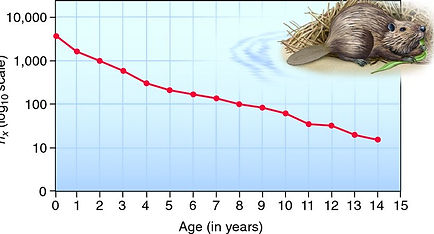Beavers are a very important species in the Mountain Bogs and across North America. They are a foundational species (a type of keystone species) because they change their environment so that they can support themselves, and provide habitats for many other organisms in the mountain bogs.
Benefits of Beaver Ponds (ecosystem services)
Direct Benefits to Humans
-
Decrease damaging floods
-
Recharge drinking water aquifers
-
Remove pollutants from surface and groundwater
-
Drought protection
-
Decreased erosion
Other Benefits
-
Produce food for fish and other animals
-
Support biodiversity, including 43% of our endangered species
-
Create vital habitats
-
Preserve open space
-
Maintain stream and river flow
-
Greater opportunities for:
-
Wildlife observation
-
Hunting and trapping
-
Canoeing / kayaking
-
Fishing
-
Photography
-
Bird watching
-
Quiet relaxation in nature
-
Beavers are a K-selected species. They do not produce a very large number of offspring at a time, and they care for their young very protectively. The young do die sometimes, but that does not make the birth rate increase any faster. ‘
Growth Rate: 2.8%
Mountain bogs are among the rarest and most imperiled habitats in the United States. They’re typically small and widely scattered across the landscape, often isolated from other wetlands.
These areas are hotspots for biodiversity and contain several uncommon and declining plant and animal species. Seventeen bog species are either federally listed under the Endangered Species Act or are species of conservation concern. Additionally, mountain bogs offer essential feeding, wintering and nesting habitat for numerous migratory bird species of national or regional conservation concern.
Bogs provide food and shelter for many important game species, including beavers and game birds. In the winter, when plants in drier areas have died, these mountain wetlands are a source of food for turkey and grouse. Bogs are also a breeding habitat for many species of amphibians.
In addition to providing specialized habitat, bogs provide important services to humans and animals downstream. Bogs possess a natural capacity for regulating water flow, holding floodwaters like giant sponges then slowly releasing the water to minimize the effects of droughts and floods. Mountain wetlands play an important role in many aquatic food chains, and contribute to the productivity and good water quality needed by downstream fishes, including native brook trout.
Bogs are usually found on fairly flat terrain where water has pooled at or near the surface. Water sources for bogs, which can originate at considerable distances from the actual bogs, must be protected in order to preserve the well-being of the bog as many bog plants and animals are sensitive to water quality and flow patterns. For example, sphagnum or peat moss is exceptionally nutrient sensitive and can be destroyed by excessive nutrient runoff in the form of fertilizer or livestock excrement. Because sphagnum acts as a living sponge - maintaining stable water levels and forming the peat other plants grow on - it’s a key species in mountain bogs.

Type-II Survivorship Curve

Growth Curve of a beaver -- the same for most K-selected species

The Diagram above is a interconnected food web that shows the aquatic mountain bog ecosystem and terrestrial spruce fir ecosystem.
*Key*
-Arrows lined with Red are terrestrial only interactions of energy transfer
-Arrows lined with Blue are aquatic only interactions of energy transfer.
-Arrows lined with Purple are interactions between the aquatic mountain bog ecosystem and the terrestrial spruce fir ecosystem.
-Producers: organisms that make their own nutrients (anything that performs photosynthesis)
-Primary/Secondary/Tertiary-Consumers: are organisms that consume other organisms to sustain themselves. Consumers are ranked in three catigories, which are based on the consumer's diet. (Consumers can be multiple exist in multiple levels. Example: Skunks eat berries, roots, insects and smaller rodents. making it both a secondary and primary consumer.)
--Primary: Animals that consume producers or decomposers.
--Secondary: Animals that consume Primary consumers.
--Tertiary: Animal that consumes secondary consumers.
-Decomposer: Organisms that consume dead producers and consumers, then decomposes the organism back into the environment.
All animals within the food web have a degrees of separation between each other. Some animals, like the Beaver, are primary consumers and are the key to the success of the ecosystem. Primary consumers are hunted by secondary and tertiary animals. many secondary and tertiary consumers hunt across multiple ecosystems. Ecosystems are interconnected, this interconnectedness is a balance that is delicate. The balance is easily shifted with the increase of human interaction.